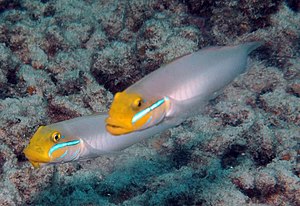Golden-browed sand goby
| Golden-browed sand goby | ||||||||||||
|---|---|---|---|---|---|---|---|---|---|---|---|---|

Valenciennea strigata |
||||||||||||
| Systematics | ||||||||||||
|
||||||||||||
| Scientific name | ||||||||||||
| Valenciennea strigata | ||||||||||||
| ( Broussonet , 1782) |
The Goldstirn-goby ( Valenciennea strigata ) is a kind from the family of gobies (Gobiidae). It is often called the golden-forehead sleeper goby , but the sleeper gobies are another family within the goby-like (Gobiiformes).
distribution
The golden-fronted sand goby lives in the entire tropical Indo-Pacific in sandy, clear lagoons and on the sandy zones between coral reefs at depths between one and 25 meters.
features
Gold-fronted sand gobies have a cigar-shaped body up to 18 centimeters long. They have high-set eyes and a large mouth, as is typical of gobies. Unlike most other gobies, their pelvic fins have not grown together to form a suction organ. In male golden-fronted sand gobies, the first rays of the first dorsal fin are elongated.
Way of life
They live in pairs in caves, which they dig under rocks lying on the sand and in which they also spawn. The female lays 1000 to 2000 eggs on the ceiling of the cave and also guards the brood, unlike most other gobies, in which the male takes on this task. The larvae hatch after two to three weeks and are wagged out of the cave by both parents. To eat, gold-fronted sand gobies filter sand through their gills and eat small crabs, other invertebrates, as well as fish eggs and fish larvae.
Aquarium keeping
With a maximum length of 18 centimeters, the golden-fronted sand goby requires a correspondingly large basin with a layer of sand several centimeters thick in which the animals can build their burrows. Due to their way of life and their form of nutrition, they are well suited to loosening up the substrate in the aquarium and keeping it clean. But they have the unpleasant peculiarity for the aquarist of climbing up with sand in their mouth and distributing it over sessile , bottom-dwelling animals such as giant clams and large polyp stony corals .
Golden-browed sleeper gobies tend to jump out of the water in frightful situations. Therefore, open pools should be bordered at least 15 cm high. Alternatively, a weak night light can be installed to help the fish find their way around.
It is an easy-to-care-for fish for the saltwater aquarium , but it should be kept in pairs.
literature
- Hans A. Baensch , Robert A. Patzner: Mergus sea water atlas. Volume 1, Mergus-Verlag, Melle, ISBN 3-88244-020-1 .
Web links
- Valenciennea strigata on Fishbase.org (English)